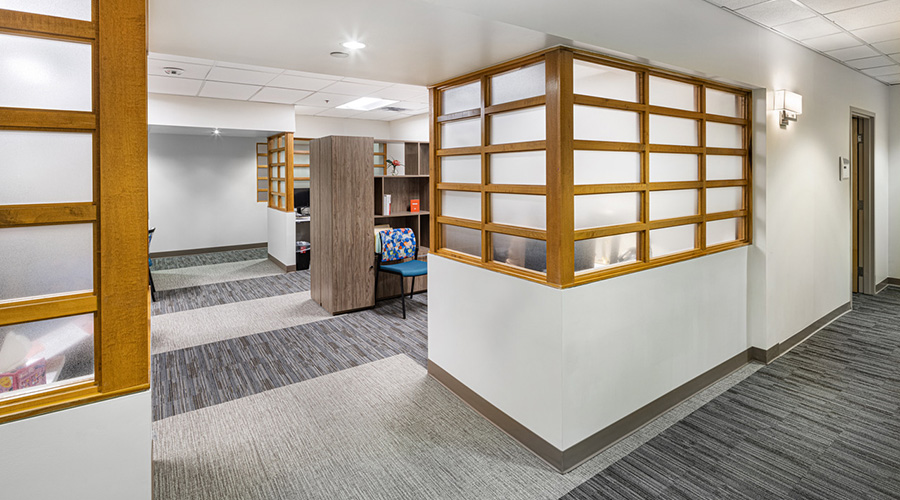Patient experience is essential to get right for healthcare facilities. If someone isn’t satisfied with their experience, it can lead to that healthcare facility getting a bad reputation and potentially losing business for the facility. Given this possibility, designing a healthcare facility must be done carefully and thoughtfully.
Intuitive Health is set to open its seventh facility in North Texas with Legacy ER & Urgent Care Prosper. The 11,072-square-foot facility offers a unique healthcare experience for patients, as it provides both an ER and urgent care in one location.
Learning from its legacy
Many of the design approaches come from the 16 years of experience Intuitive Health has, with each new facility bringing new lessons along with it, says Jay Woody, MD, FACEP, co-founder of Legacy ER & Urgent Care and chief medical officer of Intuitive Health.
One approach taken with the Prosper facility was designing it to make the flow of patients more efficient. Woody says this includes considering the number of steps taken to get to key processing points within the facility, such as the lab or X-ray areas.
“We carefully consider the number of steps required to navigate our facilities by examining the proximity of commonly used areas, such as the lab, radiology and restrooms, to patient rooms and the nurse/MD work areas,” says Woody. “Every room within the facility is strategically located to minimize the distance staff must travel to deliver care.”
Additionally, they reduced the number of steps needed by incorporating multiple access doors to key locations. For example, the urgent care rooms feature two doors which providers to enter from different work areas without having to walk around a corridor.
Being both an ER and urgent care in one facility, the Prosper location may face periods of greater patient volumes than normal. This can cause overcrowding in the facility, which can hamper the overall patient experience. However, Woody says that the Prosper facility will increase the square footage to help address capacity concerns.
“It's almost twice the size of our original building that was opened 16 years ago,” says Woody. “While not a high-tech solution, we are just building it bigger, with bigger waiting space, bigger rooms, bigger capacity in the lab, all those things to accommodate the increase in volume that we've seen and that we expect in this new location.”
Color and light
The patient experience is core to any healthcare facility, and the Prosper facility made sure to enhance it in two key areas: colors and natural lighting.
Colors and shades can have significant effects on a patient’s behavior and mood, says Nicole Cummings, AIA, director of planning, design and construction for Intuitive Health.
“As we age, our perception and feelings toward certain colors change due to the natural changes in our eyes,” says Cummings. “Numerous studies have explored how color, patterns, light and art impact a patient's health. “
While white is often associated with freshness, in healthcare settings, it can make patients feel cold, lonely, impersonal and intimidated, creating an unwelcoming environment. Meanwhile, blue can have varying effects: pastel blue is calming in high-stress situations, whereas darker blue can evoke feelings of sadness and depression.
Cummings adds that at the Prosper facility, they selected colors and materials that would promote a calming and inviting atmosphere to help relieve stress. Even the flooring was paid attention to, as they chose wood-grained properties for its warmth and inviting nature to enhance comfort.
The choice for natural lighting was backed up by research that indicated having a calming view of the outdoors and access to daylight benefited patients, says Cummings. There are several ways that natural lighting directly benefits patients, including faster healing, reduced stress, increased satisfaction, lessened perceived waiting time and lower blood pressure.
“At our locations, we design our ER rooms with outside windows to bring in natural light and incorporate skylights throughout the halls to create a warm and nurturing atmosphere,” says Cummings. “Natural light helps to calm our patients and allows our staff to enjoy the benefits of daylight, resulting in less fatigue and a more energized team.”
Legacy Health ER & Urgent Care Prosper facility is set to open fall 2024.
Jeff Wardon, Jr., is the assistant editor for the facilities market.

 Joint Commission Standards: What Updates Matter Most?
Joint Commission Standards: What Updates Matter Most? Swinerton Completes Construction at Atlanta's Grady Hospital
Swinerton Completes Construction at Atlanta's Grady Hospital NY Governor Hochul Announces $300M in Funds for IT and Cybersecurity
NY Governor Hochul Announces $300M in Funds for IT and Cybersecurity Healthcare Is the New Retail
Healthcare Is the New Retail Bridgeway Behavioral Health Services Launches Campaign to Renovate Health Center
Bridgeway Behavioral Health Services Launches Campaign to Renovate Health Center